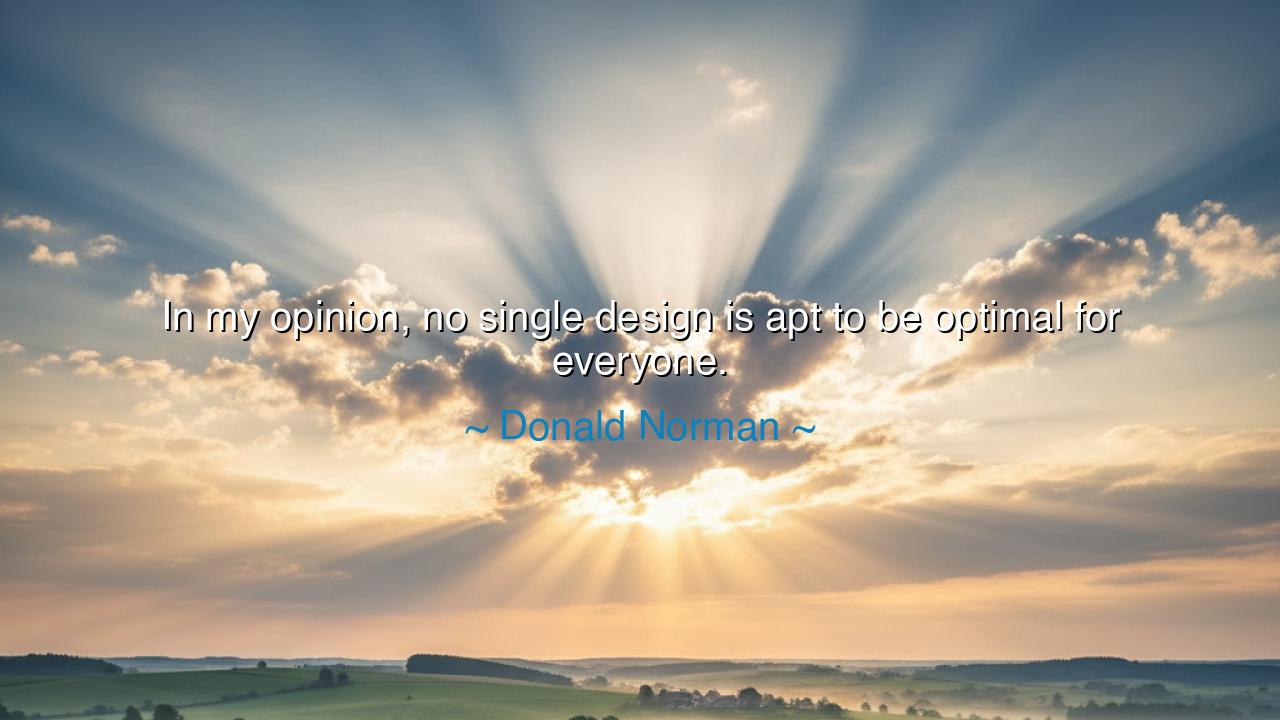
In my opinion, no single design is apt to be optimal for






“In my opinion, no single design is apt to be optimal for everyone.” — Donald Norman
Thus spoke Donald Norman, the wise scholar of human-centered design, whose words ring with the humility of understanding and the depth of observation. In this reflection, he declares a truth that transcends craft and enters philosophy: that diversity is woven into the very fabric of existence, and therefore, no one form, system, or creation can serve all souls equally. When he says, “no single design is apt to be optimal for everyone,” he does not lament a flaw in design — he celebrates the beautiful variability of human nature. For design, like life itself, is a dialogue between the universal and the individual.
The origin of these words lies in Norman’s lifelong study of how people interact with the things they use — tools, technology, and spaces that shape daily life. As the author of The Design of Everyday Things, he taught that good design begins not with the object, but with the human who touches it. He observed that every person sees, feels, and understands differently — that what is intuitive for one may be confusing for another. Thus, the designer’s task is not to seek perfection for all, but to craft systems that adapt, flex, and respond to the variety of human needs. In his wisdom, Norman reminds us that uniformity is not harmony; it is silence imposed upon the music of difference.
This truth is as ancient as it is modern. Consider the philosophers of Greece, who pondered the nature of balance and proportion. When Aristotle spoke of virtue as the “golden mean,” he meant that excellence lies between extremes — but what is “mean” for one person may be excess or deficiency for another. The same principle applies in design: what fits one hand may not fit another, what delights one mind may weary another. The master designer must think not as a tyrant imposing form, but as a servant of variety, shaping many paths for many travelers.
We may see this principle vividly illustrated in the story of Raymond Loewy, the great industrial designer who once reshaped the American landscape with his work. When asked how he approached creating for millions, Loewy replied that he sought the balance between innovation and familiarity — the “most advanced, yet acceptable.” He understood, as Norman would later echo, that there is no single design that can please all, but there can be design that invites all — that speaks in many tones, that listens as much as it declares. From his hand came trains, refrigerators, and logos that felt personal to every household, not because they were one-size-fits-all, but because they were human-sized.
Norman’s words also carry moral weight. They warn against arrogance — the arrogance of believing that one perspective can encompass all others. Whether in art, technology, or society, the insistence on one “optimal” design leads to exclusion, to the silencing of those whose needs differ. In our age, this wisdom grows ever more vital. The tools we build now — machines, systems, cities — shape not only our actions but our possibilities. To forget diversity is to forget humanity itself. The designer, like the leader or the philosopher, must learn to design with empathy, knowing that perfection is not sameness, but inclusiveness.
The lesson is this: never assume that what fits you fits all. Whether you design a product, lead a team, or speak an idea, remember that each person lives within a unique constellation of needs, memories, and dreams. Strive, then, not for a perfect design, but for a flexible one — one that welcomes difference rather than erases it. Listen before you shape; observe before you decide. For true wisdom lies not in mastering one form, but in understanding the infinite ways people meet the world.
So remember the teaching of Donald Norman: “No single design is apt to be optimal for everyone.” In this truth lies both humility and liberation. The world is vast; its people are countless; its needs ever-changing. The greatest creations are not those that impose a single order, but those that embrace multiplicity. Therefore, in all that you make — be it art, invention, or life itself — design not for yourself alone, but for the living tapestry of humankind. For to honor difference is to design for eternity.






AAdministratorAdministrator
Welcome, honored guests. Please leave a comment, we will respond soon